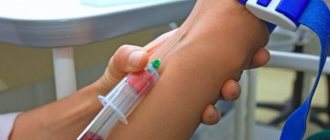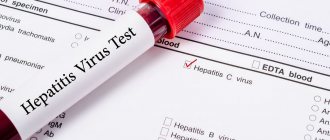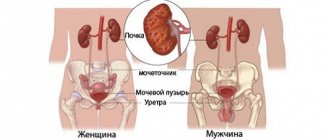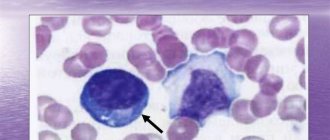Diabetes mellitus is a complex pathology that cannot be cured completely. It is important to understand here that such an established diagnosis is a person’s way of life; with proper organization of the diet, the patient simply will not feel sick. To monitor your condition, it is recommended to undergo regular examinations - determination of blood sugar, biochemical studies, as well as a general blood test for diabetes. Indicators may differ slightly from those for healthy individuals.
What tests are there for diabetes mellitus?
When primary signs of the disease appear, it is important to take blood and urine tests to determine the development of the disease in the initial stages.
- Especially if among close relatives there are people with this diagnosis.
- Blood tests can tell you about the state of the body and the prerequisites for the development of diabetes:
- Blood test for glycated hemoglobin.
- For glucose levels (in normal conditions and after eating food).
- General blood analysis;
- blood chemistry;
If the diagnosis is confirmed, the list of indicators that need to be monitored will increase significantly due to additional studies:
- for cholesterol and lipid profile;
- to c-peptide;
- kidney conditions;
- for magnesium content (hypertension);
- on the content of albumin in blood serum;
- glucose scan 2 hours after eating.
It is just as important for the patient to understand the interpretation of data received from the laboratory as it is for the treating specialist.
Fructosamine
For type 1 or type 2 diabetes, this test is recommended every 3 weeks. Its correct decoding allows you to monitor the effectiveness of the treatment and the development of complications due to diabetes mellitus. An analysis is carried out in a laboratory and blood is taken from a vein on an empty stomach for testing.
Normal levels of fructosamine in diabetes
When deciphering this analysis, it is possible to identify disorders in the body that are caused by diabetes mellitus. For example, if a patient has an elevated level of fructosamine in the blood serum, this may indicate that the diabetic has kidney problems or an overactive thyroid gland. If this indicator is below normal, then this already indicates insufficient functioning of the thyroid gland and disrupted hormonal levels, as well as the development of diabetic nephropathy.
Important! If significant deviations from the norm were identified in a diabetic during this study, then additional diagnostics are required to identify pathologies and prescribe appropriate treatment.
Features of a general blood test for diabetes mellitus
Collection of material for OBC - a general clinical blood test for diabetes mellitus (DM) is carried out from a finger on an empty stomach.
- The results of the study show quantitative indicators of blood composition, from which conclusions can be drawn about the state of the human body.
- The analysis form will contain:
Erythrocyte sedimentation rate (ESR):
- ESR - the norm is 2-15mm/h in women,
- 1-10mm/h for men,
- an increase indicates disorders that include diabetes.
Leukocytes
- leukocytes – exceeding the norm (in women/men 4-9*109/l) indicates the development of pathologies;
Red blood cells
- erythrocytes – exceeding the norm in women 3.5-5.5*1012/l,
- in men 4-5.5*1012/l),
- indicates inflammatory processes in the body;
Hemoglobin
- hemoglobin – excess of standard values in women 120-140 g/l,
- husbands 130-170g/l),
- indicates dehydration.
A change in these indicators will show the doctor the presence of pathologies or the success of the treatment.
- The OAC is carried out at least once a year.
- If exacerbations are observed, the frequency increases to 3-4 times a year.
Diabetes - types of disease
Sugar testing is one of the most important studies in the diagnosis of diabetes mellitus and other diseases that are associated with pathology of the endocrine system.
Even if a person feels well, he should periodically take a blood or urine test for sugar. Many people are interested in what tests for sugar need to be taken, is it possible to detect sugar in a general blood test, and how to take these tests correctly?
Blood sugar test
In a general blood test, sugar is not determined. There is a special blood sugar test for this.
The main producer of energy for the normal functioning of the body is glucose (sugar), which is found in human blood. Using a special analysis, blood sugar levels are determined. If the sugar level exceeds a certain norm, the patient is additionally examined for hidden diabetes.
It is very important to know how to get tested for sugar. There are several types of this analysis, each of which needs to be properly prepared.
1. A routine blood sugar test, in which blood is taken from a finger or vein. It is used to diagnose the presence or absence of sugar in the blood. Often in this case, a general blood test and a blood test for sugar are prescribed simultaneously.
For such a study, blood must be donated in the morning on an empty stomach. It is better to eat your last meal 12 hours before donating blood. Even a cup of sweet tea or a glass of juice is considered food. Before taking the test, you should not brush your teeth or chew gum.
In a sugar test, the normal blood glucose concentration should be no more than 120 mg/dL. An increase in blood sugar concentration is called hyperglycemia.
Hyperglycemia can develop with diabetes mellitus and other diseases of the endocrine system. An increase in glucose over a long period of time leads to impaired functioning of the kidneys, liver, heart, and blood vessels.
In this case, the person will constantly feel bad. A short-term increase in glucose levels often occurs as a result of physical overload, stress, pancreatic diseases, or taking certain medications.
A decrease in blood glucose levels (hypoglycemia) occurs during fasting, metabolic disorders, alcohol poisoning, liver diseases, nervous system diseases, and malignant tumors.
2. Oral glucose tolerance test or exercise test. This test is used to check whether a patient is prone to diabetes. The doctor also prescribes an oral test if latent diabetes is suspected. This analysis is called the “gold standard” in the diagnosis of type II diabetes and gestational diabetes in pregnant women.
How to get tested for sugar using this method?
The patient donates blood from a vein on an empty stomach, after which he drinks water with sugar dissolved in it. The sugar norm for adult patients is 75 g, for pregnant women – 100 g. After this, two hours later the patient’s blood is taken again.
During the period between two blood donations, you should not drink, eat, or smoke. A person should avoid physical activity, but at the same time, lying down is also not recommended for him. It is best for the patient to just sit for this time.
The oral test is used to diagnose a patient with prediabetes (impaired glucose tolerance) and diabetes. Normally, a sugar test two hours after a glucose load should show a glucose content of less than 7.8 mmol/l.
If this indicator is 7.8–10.9 mmol/l, they speak of impaired glucose tolerance (prediabetes). At a glucose level of 11.0 mmol/l and above, the result is assessed as the development of diabetes mellitus.
3. Current blood glucose test. This study is carried out 1–1.5 hours after eating.
4. Analysis for the determination of glycosylated hemoglobin. This test determines your average blood glucose level over the past two to three months. It is prescribed to patients with diabetes to regulate the dosage of antidiabetic drugs.
Urine sugar test
In a healthy person, glucose in the urine is contained in a very low concentration - 0.06–0.083 mmol/l. This sugar content in urine is not determined by standard research methods. Therefore, in a sugar test, there should normally be no sugar in the urine.
The detection of glucose in the urine is called glycosuria. Most often, sugar in a urine test occurs when there is an increased level of glucose in the blood. In many cases, a doctor will refer a patient for a urine sugar test after he or she is found to have elevated blood glucose levels. Glucosuria usually accompanies diseases such as diabetes mellitus and kidney pathologies.
A temporary slight (physiological) increase in sugar levels in the urine occurs after stress, emotional stress, taking certain medications (corticosteroids, phenamine, caffeine, diuretin), or consuming large amounts of carbohydrates. After this, the body cannot metabolize glucose for a certain period of time.
How to take a sugar test for urine testing? There are two main types of such analyses.
The first of these is morning urine analysis. For the study, collect 150–200 ml of morning urine in a clean, dry glass container (special container).
Then it is carefully closed with a lid and transported to the laboratory within six hours. Before collecting urine for analysis, you need to thoroughly clean the genitals.
This must be done so that microorganisms, which can very quickly decompose glucose, do not get into the dishes along with urine.
The second urine test for sugar is a 24-hour test. To carry it out, the patient collects urine throughout the day. To collect urine, use a large, clean glass jar, preferably dark glass. You can purchase a special container at the pharmacy for this purpose. A 24-hour urine test is more accurate and informative.
In addition to these basic tests, there are other methods for determining glucose in urine, for example, special solutions and test strips. They can be qualitative (they only determine the presence of sugar in the urine) and quantitative (they determine the amount of sugar in the urine).
ymadam.net
Modern medicine uses two basic and two additional types of tests for blood glucose concentration - these are express and laboratory methods, tests with sugar loads and a test for glycated hemoglobin.
The express method is a convenient mechanism for determining the approximate concentration of sugar at home or in the field. The laboratory method is considered more accurate, but it is carried out within one day.
A test for glycated hemoglobin is necessary as an indicator of the average glucose level over a certain period of time, usually it ranges from one to three months. It is necessary to assess the effectiveness of the treatment.
The sugar tolerance test is comprehensive - the patient's blood is taken four times over two selected hours. The first time the sampling is done in the morning under classical conditions for preparing the patient (on an empty stomach), the second - after consuming a dose of glucose (about 75 grams) and then - after 1.5 and 2 hours, respectively, for a control analysis.
Indicators of biochemical analysis in diabetes mellitus
Blood for biochemical analysis is taken from a vein.
- Biochemical studies of blood plasma can not only identify the development of pathology in the body, but also determine the degree of damage and the presence of complications.
- Today, the capabilities of medical laboratories make it possible to characterize more than a hundred biochemical parameters. When testing blood for diabetes, the main areas of interest are:
- cholesterol, lipid profile;
- C-peptide;
- creatinine;
- glucose;
- glycated hemoglobin;
- triglycides;
- lipoproteins;
- insulin;
- fructosamine;
- protein metabolism;
- pancreatic peptides.
- Separately, a number of urine tests will be required, the results of which will be superimposed on the test data to get a complete picture of the patient’s condition.
Urine donation
Most often you hear about measuring glucose in the blood, but glucose in the urine can be measured. This component acts as a vital component, since the human body obtains energy from glucose. This component appears in the blood after carbohydrates, which are always supplied with food, are broken down. In healthy people, whose insulin production is correct, this component is enough to ensure the absorption of sugar by cells. The renal tubules are responsible for the rest of the glucose. Or rather, for her delay. Therefore, if there are no violations, sugar should not be detected in urine. Its increased rate can be caused by several reasons.
If the kidneys are functioning normally, then glucose absorption occurs in full in the proximal renal tubules, from where it is sent into the blood rather than into the urine. If the concentration of glucose in the blood increases, reaching 10 mmol/l, it means that the kidneys are not able to cope with the work, and some of the glucose ends up in the urine. Another reason is a reduced renal threshold. This phenomenon inevitably manifests itself with age and in the presence of kidney diseases that occur in a chronic form.
Urine may be detected in diabetes mellitus. There are two types of this disease. Both the first and second lead to a corresponding increase. This disease is expressed not only by an increase in urinary glucose levels, but also in blood levels.
Among kidney diseases, pyelonephritis, nephrosis, kidney failure, and glomerulonephritis are dangerous in terms of increased glucose. Liver damage cannot be ruled out as a possible option. We are talking about Gierke's disease, hepatitis, cirrhosis. Sugar may be found in the urine due to diabetes, or perhaps due to brain disorders. We are talking about meningitis, encephalitis, cancer and traumatic brain injuries.
Of course, when testing for latent diabetes, such unpleasant indicators can be demonstrated due to disorders of the endocrine system. Possible reasons include:
- hemorrhagic stroke;
- acute pancreatitis;
- phosphorus poisoning.
The physiological content of glucose in urine can increase due to stressful situations, increased physical activity and overwork. Taking a number of anti-inflammatory drugs is associated with glucosuria as a side effect. Nutritional problems cannot be excluded as a cause. If you eat a lot of sweets shortly before testing, you may experience an increased score.
Blood test for cholesterol
The acceptable level of cholesterol is 2-6 mmol/l of the substance. If the subject is diagnosed with diabetes, the cholesterol content will be overestimated.
- Cholesterol monitoring is important to assess the patient's condition and, more specifically, the vascular system.
- If fat metabolism is seriously impaired, the treatment course will need to be adjusted accordingly.
Blood test for C-peptide
C-peptide is an indicator of the production of its own insulin by the pancreas.
- The normal level (same for male/female patients) is 0.9-7.1 ng/ml of the substance.
- With the development of type 1 diabetes, the indicator will be lowered.
- Diabetes mellitus, type 2, is characterized by elevated C-peptide.
- Monitoring the content of c-peptide allows you to track the quality of the pancreas.
- Based on the research data obtained, a plan to support the work of the body is drawn up.
Blood creatinine test to check kidneys for diabetes
When diabetes develops, glucose accumulates over the years, which affects kidney function.
- A biochemical blood test for creatinine allows you to check the degree of organ damage.
- The normal level of creatinine in the blood is 55-180 µmol/l of the substance.
- The level of creatinine determines the glomerular filtration rate of the kidneys.
- The more it accumulates in the body, the worse the kidneys work.
Treatment and prevention of diabetes mellitus
The main thing you need to understand is that life with diabetes is possible. But its quality directly depends on compliance with the set of therapeutic and preventive measures prescribed by the doctor.
It is important to control your glucose levels. Therefore, you should definitely purchase a glucometer with test strips for it. You need to eat a balanced diet. Avoid excess of some nutrients and deficiency of others, for example, monitor the amount of carbohydrate foods in the diet and do not exceed the recommended amount.
Physical activity has a significant impact on maintaining the quality of life of a person suffering from diabetes. Many people mistakenly believe that exercise helps control blood sugar. This is not entirely true. Don't train too hard or too intensely. It is also important to exclude extreme sports (alpine skiing, diving, surfing).
Remember, self-prescription of drugs and the use of untested, traditional methods are not effective, but also life-threatening.
Blood test for magnesium for hypertension
A sufficient magnesium content allows you to normalize blood pressure, avoid the formation of cholesterol plaques, and improve the condition of blood vessels.
- This is one of the most important components necessary for the proper functioning of the body.
- Taking into account the characteristics of diabetes mellitus and the effect of the disease on blood vessels, it is vitally important for hypertensive patients diagnosed with diabetes to control magnesium.
- Its decrease can lead to complications and worsening symptoms.
Serum albumin
Albumin not only ensures stable blood pressure. This protein element prevents fluid from leaving the vascular system.
- This prevents the formation of edema.
- Due to this protein, drugs are transported through the circulatory system.
- The normal level of albumin in the adult body ranges from 35-50 g/l of liquid.
- In patients with diabetes, the permissible value is exceeded.
Rules for donating blood
Blood is one of the most important points when it comes to making such a serious diagnosis as diabetes. However, to obtain a reliable analysis, proper preparation for the test is important. The rules are actually not complicated. A few days before the test, drinking alcohol is prohibited. Blood donation is performed on an empty stomach. Accordingly, fasting should last from eight to 12 hours, delivery is carried out in the morning.
Before taking the test, it is recommended to stop brushing your teeth and chewing gum. The fact is that these products contain sugar, which can be absorbed through the oral mucosa. If you only need to know the amount of sugar in the blood, then the sample is taken from a finger. If you are scheduled for several tests at once, then laboratory technicians prefer venous blood, which will be used in several ways at once.
In addition, it is possible to check blood glucose levels using a home glucometer. This is a portable device that allows you to evaluate your blood sugar levels. However, the glucometer does not always show reliable results. In most cases, this is due to incorrect operation of the user himself.
Speaking of normal levels, in the blood of an adult, taken on an empty stomach, according to all the rules, there should be a level of no less than 3.88 and no more than 6.38 mmol/l glucose. If we are talking about newborns, then the figures are much lower - 2.78-4.44 mmol/l. Children are also characterized by lower rates compared to adults. We are talking about numbers from 3.33 to 5.55 mmol/l.
It is important to emphasize that depending on the methodology and equipment used, each laboratory may have its own acceptable standards. It is important to focus on the indicator that is written in your test results.
Determination of blood sugar 2 hours after eating
- Glucose levels are typically measured using a three-month average.
In addition, sugar is determined before meals and two hours after meals, since the assessment criteria in these cases are different.
- The upper limit of the permissible glucose value after meals is 7.8 mmol/l of liquid.
- In subjects with diabetes, sugar levels increase both on an empty stomach and after eating.
- In women, during pregnancy, and in children, the results of this test will differ from the average value.
- The normal indicator for such “special” subjects is calculated by the doctor individually.
Glucometer
- It should be noted that only a complex of studies will provide a complete picture of the condition.
- Separately, each of the components signals only the presence of pathologies.
- The nature and degree of development of the disease can only be determined using an integrated approach to diagnosis.
Diet for diabetes and high blood sugar
If you have prediabetes (fasting blood glucose 5.6–6.9 mmol/l), this is a reason to at least make serious lifestyle changes and sometimes start drug therapy. If you do nothing, diabetes will not take long to develop.
Products that can be consumed without restriction: all vegetables except potatoes (preferably boiled rather than fried), as well as tea, coffee without cream and sugar.
Foods that can be consumed in moderation (eat half as much as usual): bread, cereals, fruits, eggs, lean meat, lean fish, low-fat dairy products, cheese less than 30% fat, potatoes, corn.
Foods that should be excluded from your daily diet:
- products with a high fat content: butter, fatty meat, fish, smoked meats, sausage, canned food, cheese with a fat content of >30%, cream, sour cream, mayonnaise, nuts, seeds;
- sugar, as well as confectionery, sweets, chocolate, jam, jam, honey, sweet drinks, ice cream;
- alcohol.
And a few more simple rules that will be useful for those who have elevated glucose levels:
- Eat raw vegetables and fruits; adding butter and sour cream to salads increases their calorie content.
- Choose products with low fat content. This applies to yoghurts, cheese, cottage cheese.
- Try not to fry foods, but to boil, bake or stew them. Such processing methods require less oil, which means the calorie content will be lower.
- “If you want to eat, eat an apple. If you don’t want an apple, you don’t want to eat it.” Avoid snacking on sandwiches, chips, nuts, etc.
Advertising
Diabetes, a precursor to pancreatic cancer
Oncologists have called diabetes a precursor to pancreatic cancer.
- Patients with type 2 diabetes have an increased risk of pancreatic cancer.
- Scientists note that diabetics are at risk, so doctors should pay more attention to diagnosing pancreatic cancer in such patients.
- Further research is also needed to identify the disease in its early stages.
Who should I give it to and why?
Most often, such studies are carried out on the direction of a general practitioner or endocrinologist, to whom a person turns after the appearance of significantly pronounced signs of the disease. However, every person needs to control their glucose levels.
Such an analysis is especially necessary for people belonging to various risk groups for diabetes. Traditionally, experts identify three main risk groups for this endocrine disease.
The analysis must be taken:
- those who have a history of diabetes in their family;
- people who are obviously overweight;
- suffering from arterial hypertension.
Strict control is necessary to prevent the development of the disease. After all, diabetes usually does not appear suddenly.
Typically, the disease is preceded by a fairly long period when insulin resistance slowly increases, accompanied by an increase in blood glucose levels. Therefore, it is worth donating blood to patients at risk once every six months.
People with diagnosed diabetes need regular comprehensive blood analysis to better monitor the general condition of the body and the course of the disease.











